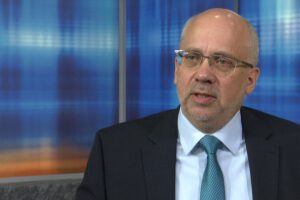In a year of high-profile statewide election battles in Montana, there’s one flying under the radar that almost wasn’t a contest at all: Montana Supreme Court Justice Laurie McKinnon vs. challenger Mike Black, a Helena lawyer.
McKinnon, 60, announced in June 2019 that she would not run for re-election to a second eight-year term – and later that month, Black said he would run for the seat.
But five months later, McKinnon changed her mind and announced that she would run for another term.

“I got some good advice from friends (who said) the worst reason not to run was the fear of losing, or that you didn’t want to run the race,” she told MTN News this week. “So I really decided I should follow that advice, and I ran.”
Black, 58, stayed in the race, survived a three-person primary, and is now arguing that he’s the better choice for this nonpartisan, contested seat on the seven-member high court.
“With my background, growing up in Montana, I just think I’m more suited to address the issues that are going to be important for Montana as we move forward,” he told MTN News in an interview. “We all want Montana to stay a wonderful place. It’s never going to be exactly as it was, but it’s important to try to preserve it the best we can.”
Black said his background in civil litigation is more diverse than McKinnon’s, and that he’s dedicated to preserving rights unique to Montana’s state constitution, such as rights to privacy, dignity, a clean and healthful environment and to fish and hunt.

Black grew up in Havre, earned his undergraduate degree from the University of Montana and his law degree from Cornell University in Ithaca, N.Y. He’s worked as a lawyer in private practice in Montana; for the Montana Legal Services Association, which represents low-income people in civil cases; and as an assistant attorney general for the state.
McKinnon grew up in Baltimore and got her law degree from the University of Baltimore, but has lived in Montana since 1995, mostly in Choteau. She worked as a deputy county attorney for Teton and Glacier counties before winning a state district judgeship in north-central Montana in 2006.
She ran for and won an open seat on the Supreme Court in 2012.
“There is no question that I’m committed to Montana,” she said. “All of our kids are here … This is our home.”
Her husband, Gary Pannabecker, who worked as a dentist at the Indian Health Service in Browning, had taken a job with a clinic in North Carolina – which McKinnon cited last year as one reason for choosing initially not to run for re-election. Yet he’s left that position and is now working back in Montana, she said, and plans to rejoin the IHS in Wolf Point.
McKinnon sometimes is seen as part of the court’s conservative wing, but she insists that characterization is misplaced.
“You can’t categorize my decisions one way or the other,” she said. “I think that’s why we have seven justices on the court – so that we make a collective decision. We all are trying to make the best decision that we can, based on the law.”
McKinnon called the judiciary the “silent branch of government” that should be independent and serve as a “final constitutional check” on actions by the Legislature or executive branch.
McKinnon has been part of dissents on some higher-profile cases where the Supreme Court majority decided against conservative litigants.
But she also authored the court’s 2018 ruling that struck down a state tax credit benefiting students at private, religious schools in Montana – a decision that conservatives appealed to the U.S. Supreme Court, and won, on a landmark 5-4 ruling this year.
“I think the U.S. Supreme Court got that one wrong,” McKinnon said. “That was a real loss for Montana, in a sense that we were trying to navigate a course that was unique for Montana and our constitution.”
The nation’s high court overruled a portion of Montana’s state constitution that banned public aid to churches or religion-affiliated institutions.
Black said he sees some of McKinnon’s dissents as more political, than based in law, such as one this month, when she would have allowed a Public Service Commission order that undercut solar-power development in Montana, and a 2018 dissent in a case that upheld the state’s $6.1 million purchase of a conservation easement on an eastern Montana ranch.
In the latter case, she said the Land Board should have to approve the easement, which Gov. Steve Bullock had approved after the board declined to. She was the only justice to dissent from a majority decision that said the easement was not an acquisition of land.
“I would suggest to you that Justice McKinnon doesn’t necessarily honor precedent,” Black said. “She doesn’t apply her legal principles … in a consistent way.”
McKinnon said in both cases, she based her decision on her reading of the law – “It was not partisan or politically motivated by me at all.”
Both candidates also point to their experience, as a reason to place them on the court.
Black notes his extensive work in civil litigation, which is often before the court; his work for the state on complex cases, such as defending campaign-finance law, and representing a wide array of clients, from businesses to low-income individuals.
“I’ve represented mining companies and railroads and insurance companies and I’ve sued mining companies and railroads,” he said. “I understand what it’s like to have a business in Montana.”
McKinnon said her experience as a district judge and, now, almost eight years on the Supreme Court makes her a good fit for the job.
“I’m a much better justice than I was when I first took the bench,” she said. “It takes a while to get up to speed and know what you’re doing.”




